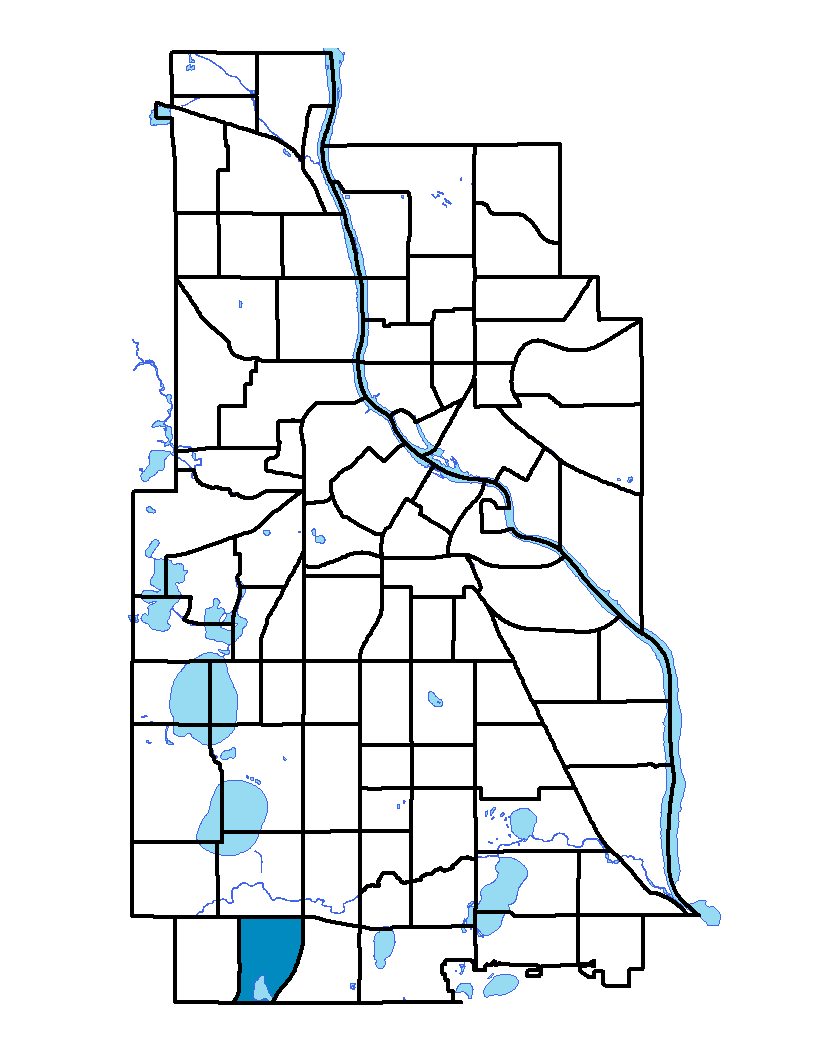Kenny neighborhood is located in southwest Minneapolis. It is bordered by Highway 62, 54th Street, Lyndale Avenue on the east, and Logan Avenue South on the west. The neighborhood, its park and its elementary school were named for Sister Elizabeth Kenny, an Australian nurse who developed the Kenny method of treating polio. The neighborhood has a lake on its south end called Grass Lake. Houses in the neighborhood tend to have been built in the 1940s or later and are generally larger than the houses in adjacent neighborhoods such as Armatage and Windom. The neighborhood has a balanced mix of longtime and new residents.
To learn more about the neighborhood association visit: www.kennyneighborhood.org
Indicator Details
| Indicators | Primary Domain | Indicator Value |
Rank |
Tier |
|---|---|---|---|---|
| Age of Housing | Housing | 96.7% | 85 | Bottom |
| Transit Accessibility | Transportation | 138.1 | 84 | Bottom |
| Commute Mode Share | Transportation | 12.6% | 84 | Bottom |
| Household Transportation Costs | Transportation | 19.5% | 82 | Bottom |
| Walkability | Neighborhood Characteristics | 39 | 75 | Bottom |
| Business Retention | Economic Health | -1.6% | 70 | Bottom |
| Access to Parks and Open Space | Natural Areas | 2.2% | 66 | Bottom |
| Tree Cover | Natural Areas | 26.4% | 61 | Bottom |
| Toxic Releases from Facilities | Environmental Hazards | 6.0% | 49 | Middle |
| Residential Proximity to Traffic | Environmental Hazards | 1.5% | 39 | Middle |
| Long-Term Unemployment | Employment Opportunities | 5.2% | 37 | Middle |
| Vacancy Rates | Housing | 5.7% | 26 | Top |
| Proximity to Brownfield Sites | Environmental Hazards | 1.5% | 26 | Top |
| Preventable Hospitalizations | Health Systems and Public Safety | 1.7 | 23 | Top |
| Pedestrian Connectivity | Transportation | 168.1 | 18 | Top |
| Preschool Enrollment | Educational Opportunities | 67.8% | 18 | Top |
| Employment Rate | Employment Opportunities | 74.7% | 16 | Top |
| Blood Lead Levels in Children | Housing | 1.6% | 15 | Top |
| Travel Time to Work | Employment Opportunities | 20.4 minutes | 15 | Top |
| Chronic School Absence | Health Systems and Public Safety | 35.0% | 12 | Top |
| Access to Mainstream Financial Services | Economic Health | 11.5% | 11 | Top |
| Public Assisted Households | Employment Opportunities | 4.4% | 10 | Top |
| Local Business Vitality | Economic Health | 68.6% | 10 | Top |
| Voter Participation | Social Cohesion | 44.4% | 8 | Top |
| Reading Proficiency | Educational Opportunities | 73.3% | 7 | Top |
| Motor Vehicle Collisions | Health Systems and Public Safety | 0.9 | 7 | Top |
| Residential Mobility | Social Cohesion | 90.2% | 6 | Top |
| Adult Educational Attainment | Educational Opportunities | 98.7% | 5 | Top |
| Excessive Housing Cost Burden | Housing | 16.5% | 3 | Top |
| Violent Crime | Health Systems and Public Safety | 15.9 | 2 | Top |
| School Proximity to Traffic | Environmental Hazards | 0.0% | 1 | Top |
| Proximity to Superfund Sites | Environmental Hazards | 0.0% | 1 | Top |
| Low Birth Weight | Health Systems and Public Safety | 1.0% | 1 | Top |
| Offsite Alcohol Outlets | Neighborhood Characteristics | - | - | Data N/A |
| High School Graduation Rate | Educational Opportunities | -% | - | Data N/A |
| School Readiness Scores | Educational Opportunities | -% | - | Data N/A |
| Food Desert | Neighborhood Characteristics | -% | - | Data N/A |

